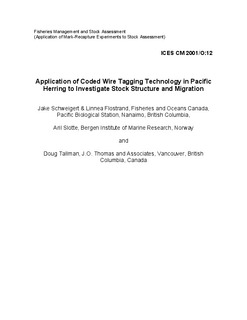Application of Coded Wire Tagging Technology in Pacific Herring to Investigate Stock Structure and Migration
Abstract
Tagging of Pacific herring in British Columbia has a long history dating to the mid-1930s but uncertainty in tag recovery locations and low tag return rates limited the utility of these studies. Currently, a larger and more stringent Pacific herring tagging data set is desired to monitor the movement and mixture of fish interannually. From 1999 to 2001, a program was implemented employing coded wire microtags to mark Pacific herring on the spawning grounds.
Methodologies for capturing, holding, tagging and releasing tagged herring were developed during coded wire tag insertion trials. Tag detection tubes designed for recovery of tagged Pacific salmon were adapted to detect and recover CWTs in fish plants during herring roe extraction processing. Screening of commercial catches from five coastal regions was conducted in 2000, but in 2001, screening of catches from only three regions was conducted due to closures in two regions. Out of 558 interannual tag recoveries, four remarkable strays were recovered from 461 one year at large recoveries and no strays were recovered from 97 two year at large recoveries.
Recovery rates were derived for reference purposes to characterise efficiencies in acquiring tag returns. From both 2000 and 2001 tag returns, one year at large recovery rates ranged from 0.07 to 0.3% (0.3 to 1.1% when adjusted for screening coverage) and two year at large tag return recovery rates were approximately 0.2 % (0.7 to 0.8% when adjusted for screening coverage). Pacific herring CWT data will eventually be integrated with other sampling data describing Pacific herring stocks. Field trials indicated the feasibility of cost effective application of large numbers of tags during short spawning seasons and captivity trials indicated high survival and low tag shedding after coded wire tag insertion. Coded wire tagging technology appears to be useful for large scale marking experiments on smaller pelagic species. Results and methods from these approaches should have broad application for stock structure and mark-recapture studies.
Publisher
ICESSeries
ICES CM documents2001/O:12
